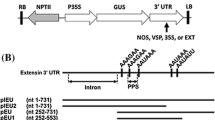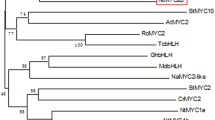Abstract
To improve the accumulation of recombinant human epidermal growth factor (hEGF) in transgenic tobacco, a highly effective vector was constructed and transformed via Agrobacterium tumefaciens. The hEGF content in transgenic tobacco was up to 0.3% of the total soluble protein. Using the Vero E6 cell expansion assay and the MTT method for cell proliferation, hEGF produced by transgenic tobacco significantly stimulated Vero E6 cell expansion and proliferation, the same as commercial hEGF products.





Similar content being viewed by others
References
Conrad U, Fiedler U (1998) Compartment-specific accumulation of recombinant immunoglobulins in plant cells: an essential tool for antibody production and immunomodulation of physiological functions and pathogen activity. Plant Mol Biol 38:101–109
Daniell H, Streatfield SJ, Wycoff K (2001) Medical molecular farming: production of antibodies biopharmaceuticals and edible vaccines in plants. Trends Plant Sci 6:219–226
Higo K, Saito Y, Higo H (1993) Expression of a chemically synthesized gene for human epidermal growth factor under the control of mosaic virus 35S Promoter in Transgenic Tobacco. Biosci Biotechnol Biochem 57:1477–1481
Hood EE, Witcher DR, Maddok S, Meyer T, Baszczynski C, Bailey M, Flynn P, Register J, Marshall L, Bond D, Kulisek E, Kusnadi A, Evangelista R, Nikolov Z, Wooge C, Mehigh RJ, Hernan R, Kappel WK, Ritland D, Ping LC, Howard JA (1997) Commercial production of avidin from transgenic maize: characterization of transformant, production, processing, extraction and purification. Mol Breed 3:291–306
Lee TH, Kim SJ, Han YM, Yu DY, Lee CS, Choi YJ, Moon HB, Baik MG, Le KK (1998) Matrix attachment region sequences enhanced the expression frequency of a whey acidic protein/hman lactoferrin fusion gene in the mammary gland of transgenic mice. Mol Cells 8:530–536
Ma JK, Hein MB (1996) Antibody production and engineering in plants. Ann NY Acad Sci 792:73–81
Mason HS, Arntzen CJ (1995) Transgenic plants as vaccine production systems. Trends Biotechnol 13:388–392
Mosmann T (1983) Rapid colorimetric assay for cellular growth and survival: application to proliferation and cytotoxicity assays. J Immunol Methods 65:55–63
Munro S, Pelham HR (1987) A C-terminal signal prevents secretion of luminal ER proteins. Cell 48:899–907
Napier RM, Fowke LC, Hawes C, Lewis M, Pelham HR (1992) Immunological evidence that plants use both HDEL and KDEL for targeting proteins to the endoplasmic reticulum. J Cell Sci 102:261–271
Pelham HR, Hardwick KG, Lewis MJ (1988) Sorting of soluble ER proteins in yeast. EMBO J 7:1757–1762
Perlak FJ, Fuchs RL, Dean DA, McPherson SL, Fischhoff DA (1991) Modification of the coding sequence enhances plant expression of insect control protein genes. Proc Natl Acad Sci USA 88:3324–3328
Staub JM, Garcia B, Graves J, Peter TJH, Priscilla H, Narender N, Vikram P, Michael S, James AC, Lori S, Dannette W, Guangning Y, Douglas AR (2000) High-yield production of a human therapeutic protein in tobacco chloroplasts. Nature Biotechnol 18:333–339
Strick R, Laemmli UK (1995) SARs are cis DNA elements of chromosome dynamics: synthesis of a SAR repressor protein. Cell 83:1137–1148
Whitelaw CB, Grolli S, Accornero P, Donofrio G, Farini E, Webster J (2000) Matrix attachment region regulates basal beta-lactoglobulin transgene expression. Gene 244:73–80
Willbur HC, Gowri G (1990) Codon usage in higher plants, green algae, and cyanobacteria. Plant Physiol 92:1–11
Wirth S, Calamante G, Mentaberry A, Bussmann L, Lattanzi M, Barañao L, Bravo-Almonacid F (2004) Expression of active human epidermal growth factor (hEGF) in tobacco plants by integrative and non-integrative systems. Mol Breed 13:23–35
Zhong J, Liu SJ, Ma SS, Yang W, Hu YL, Wu Q, Lin ZP (2004) Effect of matrix attachment regions on resveratrol production in tobacco with transgene of stilbene synthase from Parthenocissus henryana. Acta Bot Sin 46:948–954
Author information
Authors and Affiliations
Corresponding author
Rights and permissions
About this article
Cite this article
Bai, JY., Zeng, L., Hu, YL. et al. Expression and characteristic of synthetic human epidermal growth factor (hEGF) in transgenic tobacco plants. Biotechnol Lett 29, 2007–2012 (2007). https://doi.org/10.1007/s10529-007-9438-y
Received:
Revised:
Accepted:
Published:
Issue Date:
DOI: https://doi.org/10.1007/s10529-007-9438-y




